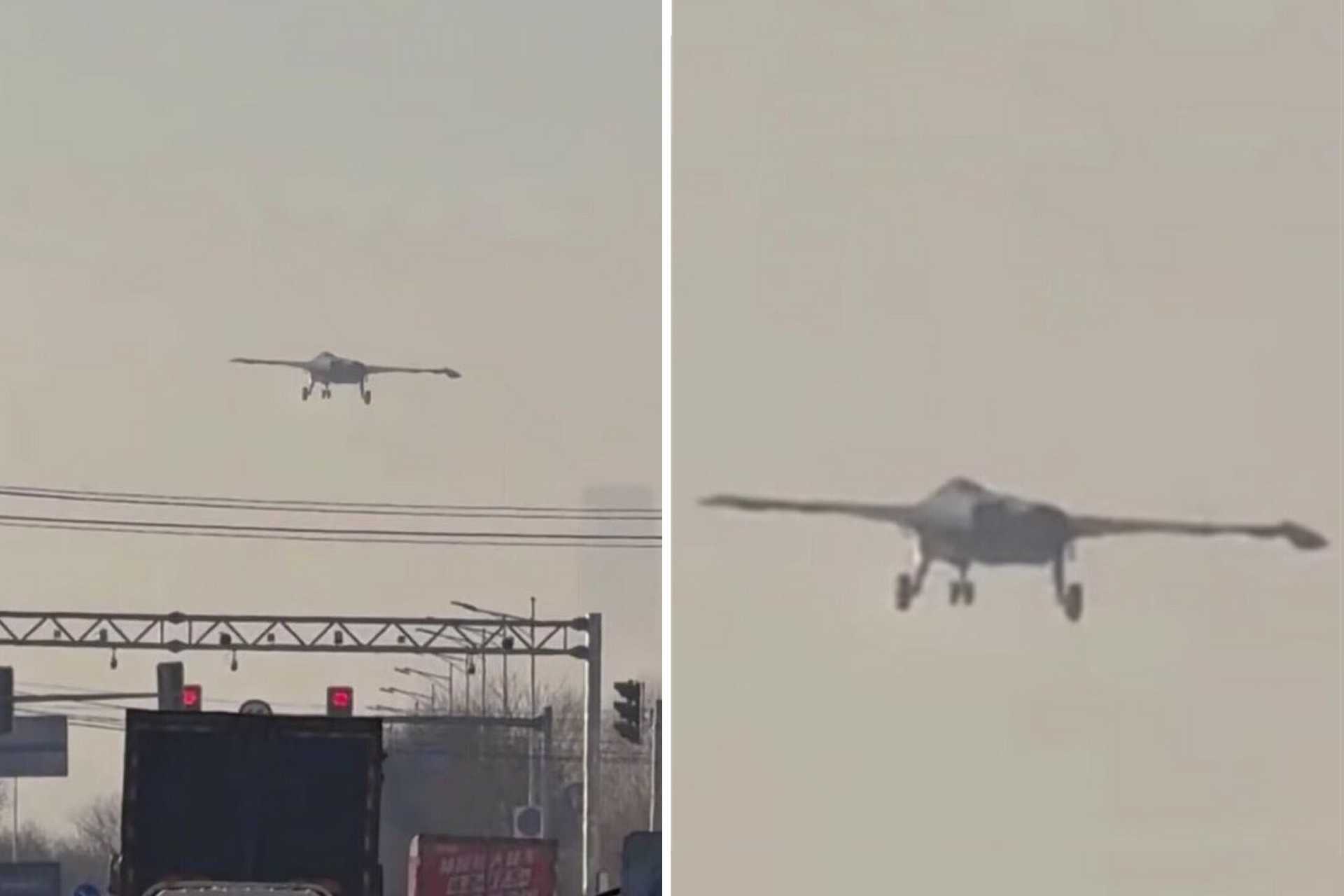Exclusive: New Images Reveal Unique Design Features of China’s J-XDS 6th Generation Fighter

{loadposition bannertop}
{loadposition sidebarpub}
Recent images shared on the Chinese social media platform Weibo have unveiled a striking new design for China’s J-XDS, a sixth-generation fighter jet. This latest release has provided valuable insight into the aircraft’s unique features, signaling a major leap forward in China’s pursuit of air dominance. Among the most notable aspects of the J-XDS design is the inclusion of full-moving wingtips, which are rarely seen in traditional fighter aircraft. Follow Army Recognition on Google News at this link
Newly released images on the Chinese Social Network of China’s J-XDS sixth-generation fighter showcase a revolutionary tailless design and full-moving wingtips, highlighting advancements in stealth, maneuverability, and next-generation aerodynamics. (Picture source: Chinese Social Network Weibo)
This design choice suggests that the J-XDS is optimized for greater aerodynamic flexibility, enhancing its maneuverability during high-speed or complex flight operations. The full-moving wingtips likely play a crucial role in improving the jet’s agility, enabling it to make rapid adjustments during various phases of flight and possibly contributing to its stealth capabilities by reducing turbulence and drag.Another defining feature of the J-XDS is its absence of angled vertical stabilizers, a departure from conventional fighter designs. This tailless configuration is a key characteristic of sixth-generation aircraft and represents a significant shift in the design philosophy aimed at reducing drag and improving overall fuel efficiency. Without the traditional stabilizers, the aircraft benefits from a streamlined shape that enhances its stealth profile, making it less detectable by enemy radar systems. The absence of these components could also indicate a more advanced flight control system, likely a sophisticated fly-by-wire system that manages the aircraft’s stability and control during aggressive maneuvers.
These design choices suggest that the J-XDS is built with an emphasis on both stealth and maneuverability. The elimination of vertical stabilizers not only reduces radar cross-section but also allows for a cleaner airflow around the aircraft, which is crucial for minimizing infrared signatures and reducing its vulnerability to infrared sensors. This makes the J-XDS a formidable asset for air superiority missions, where stealth and agility are paramount.
In the broader context of China’s military ambitions, the J-XDS fits into the country’s ongoing efforts to modernize its air force and achieve dominance in critical regions such as the South China Sea and Taiwan. The fighter’s design suggests that it is not only intended for air superiority but also for multi-role capabilities, including long-range strike missions. As China continues to test and refine this aircraft, it could potentially become a centerpiece of the People’s Liberation Army Air Force (PLAAF), offering advanced capabilities in both manned and unmanned operations.
The J-XDS is being seen by many as a technology demonstrator, showcasing China’s ability to rapidly innovate and integrate next-generation technologies into its military hardware. In terms of design and performance, it aligns with global trends in sixth-generation fighter development, focusing on advanced avionics, sensor fusion, and networked capabilities. As part of China’s broader strategy to challenge existing powers like the United States, the J-XDS could serve as a cornerstone of its efforts to maintain air superiority and expand its influence in the region.
Furthermore, the J-XDS is virtually guaranteed to incorporate cutting-edge subsystems and technologies in areas like propulsion, sensors, computing, and networking. These advancements will likely make the J-XDS an even more formidable force, particularly in operations alongside unmanned combat aerial vehicles (UCAVs) or collaborative combat aircraft (CCAs), which are expected to play an integral role in future combat scenarios. The combination of manned and unmanned platforms could redefine aerial operations, enabling highly coordinated and dynamic strike missions.
The fighter’s features, including its unique wing design and tailless configuration, are likely just the beginning of a more comprehensive program aimed at redefining the capabilities of modern air combat. With China’s accelerating development in this field, the J-XDS stands as a clear indicator that the next generation of fighter aircraft will be radically different from what we know today—combining advanced stealth, enhanced maneuverability, and the ability to operate in tandem with unmanned systems for a more integrated and lethal fighting force. As these developments unfold, the global defense community will closely monitor China’s progress and its potential to reshape the future of aerial combat.
The Chinese aerospace sector’s continued focus on sixth-generation fighter aircraft development, including the J-XDS, signals a clear commitment to leading the global arms race in advanced military aviation. Along with the J-20, which has already established itself as a formidable stealth fighter, the J-XDS marks a significant step toward an entirely new class of air combat systems. With innovations in autonomy, AI integration, and network-centric warfare, China’s next-generation fighters will not only dominate the skies but also integrate seamlessly with a broader ecosystem of autonomous combat systems—further bolstering the nation’s strategic capabilities.

{loadposition bannertop}
{loadposition sidebarpub}
Recent images shared on the Chinese social media platform Weibo have unveiled a striking new design for China’s J-XDS, a sixth-generation fighter jet. This latest release has provided valuable insight into the aircraft’s unique features, signaling a major leap forward in China’s pursuit of air dominance. Among the most notable aspects of the J-XDS design is the inclusion of full-moving wingtips, which are rarely seen in traditional fighter aircraft.
Follow Army Recognition on Google News at this link
Newly released images on the Chinese Social Network of China’s J-XDS sixth-generation fighter showcase a revolutionary tailless design and full-moving wingtips, highlighting advancements in stealth, maneuverability, and next-generation aerodynamics. (Picture source: Chinese Social Network Weibo)
This design choice suggests that the J-XDS is optimized for greater aerodynamic flexibility, enhancing its maneuverability during high-speed or complex flight operations. The full-moving wingtips likely play a crucial role in improving the jet’s agility, enabling it to make rapid adjustments during various phases of flight and possibly contributing to its stealth capabilities by reducing turbulence and drag.
Another defining feature of the J-XDS is its absence of angled vertical stabilizers, a departure from conventional fighter designs. This tailless configuration is a key characteristic of sixth-generation aircraft and represents a significant shift in the design philosophy aimed at reducing drag and improving overall fuel efficiency. Without the traditional stabilizers, the aircraft benefits from a streamlined shape that enhances its stealth profile, making it less detectable by enemy radar systems. The absence of these components could also indicate a more advanced flight control system, likely a sophisticated fly-by-wire system that manages the aircraft’s stability and control during aggressive maneuvers.
These design choices suggest that the J-XDS is built with an emphasis on both stealth and maneuverability. The elimination of vertical stabilizers not only reduces radar cross-section but also allows for a cleaner airflow around the aircraft, which is crucial for minimizing infrared signatures and reducing its vulnerability to infrared sensors. This makes the J-XDS a formidable asset for air superiority missions, where stealth and agility are paramount.
In the broader context of China’s military ambitions, the J-XDS fits into the country’s ongoing efforts to modernize its air force and achieve dominance in critical regions such as the South China Sea and Taiwan. The fighter’s design suggests that it is not only intended for air superiority but also for multi-role capabilities, including long-range strike missions. As China continues to test and refine this aircraft, it could potentially become a centerpiece of the People’s Liberation Army Air Force (PLAAF), offering advanced capabilities in both manned and unmanned operations.
The J-XDS is being seen by many as a technology demonstrator, showcasing China’s ability to rapidly innovate and integrate next-generation technologies into its military hardware. In terms of design and performance, it aligns with global trends in sixth-generation fighter development, focusing on advanced avionics, sensor fusion, and networked capabilities. As part of China’s broader strategy to challenge existing powers like the United States, the J-XDS could serve as a cornerstone of its efforts to maintain air superiority and expand its influence in the region.
Furthermore, the J-XDS is virtually guaranteed to incorporate cutting-edge subsystems and technologies in areas like propulsion, sensors, computing, and networking. These advancements will likely make the J-XDS an even more formidable force, particularly in operations alongside unmanned combat aerial vehicles (UCAVs) or collaborative combat aircraft (CCAs), which are expected to play an integral role in future combat scenarios. The combination of manned and unmanned platforms could redefine aerial operations, enabling highly coordinated and dynamic strike missions.
The fighter’s features, including its unique wing design and tailless configuration, are likely just the beginning of a more comprehensive program aimed at redefining the capabilities of modern air combat. With China’s accelerating development in this field, the J-XDS stands as a clear indicator that the next generation of fighter aircraft will be radically different from what we know today—combining advanced stealth, enhanced maneuverability, and the ability to operate in tandem with unmanned systems for a more integrated and lethal fighting force. As these developments unfold, the global defense community will closely monitor China’s progress and its potential to reshape the future of aerial combat.
The Chinese aerospace sector’s continued focus on sixth-generation fighter aircraft development, including the J-XDS, signals a clear commitment to leading the global arms race in advanced military aviation. Along with the J-20, which has already established itself as a formidable stealth fighter, the J-XDS marks a significant step toward an entirely new class of air combat systems. With innovations in autonomy, AI integration, and network-centric warfare, China’s next-generation fighters will not only dominate the skies but also integrate seamlessly with a broader ecosystem of autonomous combat systems—further bolstering the nation’s strategic capabilities.




